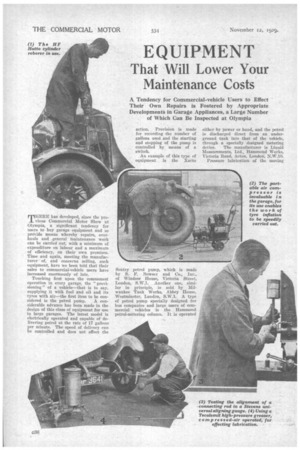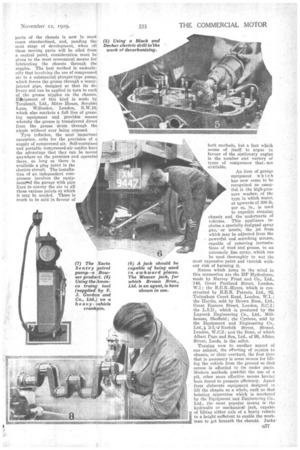EQUIPMENT
Page 206

Page 207

Page 208

If you've noticed an error in this article please click here to report it so we can fix it.
That Will Lower Your Maintenance Costs
A Tendency for Commercial-vehicle Users to Effect Their Own Repairs is Fostered by Appropriate Developments in Garage Appliances, a Large Number of Which Can Be Inspected at Olympia
MHERE has developed, since the pre vious Commercial Motor Show at Olympia, a significant tendency for users to buy garage equipment and so provide means whereby repairs, overhauls and general maintenance work can be carried out, with a minimum of expenditure on labour and a maximum of efficiency, on their own premises. Time and again, meeting the manufacturer of, and concerns selling, such equipment, have we been told that their sales to commercial-vehicle users have increased enormously of late.
Touching first upon the commonest operation in every garage, the " provisioning " of a vehicle—that is to say, supplying it with fuel and oil and its tyres with air—the first item to he con
sidered is the petrol pump. A considerable advance has been made in the design of this class of equipment for use in large garages. The latest model is electrically operated and capable of delivering petrol at the rate of 17 gallons per minute. The speed of delivery can be controlled and does not affect the
action. Provision is made for recording the number of gallons used and the starting and stopping of the pump is controlled by means of a switch.
An example of this type of equipment is the Xacto Sentry petrol pump, which is made by S. F. Bowser and Co., Inc., of Windsor House, Victoria Street, London, S.W.1. Another one, similar in principle, is sold by Milwaukee Tank Works, Abbey House, Westminster, London, S.W.1. .A type of petrol pump specially designed for bus companies and large users of commercial vehicles is the Hammond petrol-metering column. It is operated
either by power or hand, and the petrol is discharged direct from an underground tank into that of the vehicle, through a specially designed metering
device. The manufacturer is Liquid Measurements, Ltd., Hammond Works, Victoria Road, Acton, London, N.W.10. Pressure lubrication of the moving
parts of the chassis is now in most eases standardized, and, pending the next stage of development, when all these moving parts will be oiled from a central point, consideration must be given to the most economical means for lubricating the chassis through the nipples. The best method is undoubtedly that involving the use of compressed air in a substantial plunger-type pump, which forces the grease through a manyjointed pipe, designed so that its delivery end can be applied in turn to each of the grease nipples on the chassis. Edlaipment of this kind is made by Tecalemit, Ltd., Mitre House, Scrubbs Lane, Willesden, London, N.W.10, which also markets a full line of greasing equipment and provides means whereby the grease is transferred direct from the grease drum through the nipple without ever being exposed.
Tyre inflation, the next important operation, calls for the provision of a supply of compressed air. Self-contained and portable compressed-air outfits hare the advantage that they can be moved anywhere on the premises and. operated there, so long as there is available a ping point in the electric circuit. The installation of an independent compressor involves the equipment*of the garage with pipe lines to convey the air to all those various points at which It may be needed. There is much to he said in favour of both methods, but a fact which seems of itself, to argue' in favour of the stationary engine is tke . number and variety of types of compressor that. are available.
An item of garage equipment w h i oh has now come to be recognized as essential is the high-pressure washer, of the type in which water, at upwards of MO lb. per sq. in., is used to expedite cleaning chassis and the underparts of vehicles. This appliance includes a specially designed spray gun,'. or nozzle, the jet from which may be adjusted from the powerful and searching stream, capable of removing incrustations of mod and grease, to an extremely fine spray, which can be used thoroughly to wet the most expensive paint and varnish without risk of harming it.
Names which jump to the mind in this connection are the BF Hydroforce, made by Harvey Frost and Co., Ltd., 148, Great Portland Street, London, W.1 ; the B.E.N.-Myers, which is constructed by B.E.N. Patents, Ltd. 92, Tottenham Court Road, London, *.1. ; the Hardie, sold by Brown Bros., Ltd., Great Eastern Street, London, E.C.2 ; the L.S.D., which is produced by the Laycock Engineering Co., Ltd., Millhouses, Sheffield-; the Cyclone, sold by the Equipment and Engineering Co., Ltd.,-; 2-3,-..?Norfolk Street, Strand, London, W.C.2 ; and the Bean, of which Albert Page and Son, Ltd., of 99, Albion Street, Leeds, is the seller.
Turning now to another aspect of our subject, the effectingof repairs to chassis, or their overhaul, the first item that is necessary is some means for lifting the vehicle from the ground so that access is afforded to its under parts. Modern methods prthibit the use of a
• pit, other more effective means having been found to promote efficiency. Apart from elaborate equipment designed to lift the chassis as a whole, such as that hoisting apparatus which is marketed . by the Equipment and Engineering Co., Ltd., the most popular means is the hydraulic or mechanical jack, capable of lifting either axle of a heavy vehicle to a height sufficient to enable the workman to get beneath the chassis. Jacks.
of this description are manufactured or sold by Harvey Frost and Co., Ltd.; B.E.N. Patents, Ltd.; Lake and Elliott, Ltd.; Delco-Remy and Hyatt, Ltd., and others. In selecting equipment of this type preference should be given to that which can be used when access to either axle is difficult, as, for example; when the body overhangs a long way behind the rear axle.
Having elevated the axle by means of a jack, it is usually convenient to provide some means for supporting it, not only so as to liberate the jack for other work, which would be sufficient reason in itself, but because it is often inconvenient to leave the jack in position while the work is going forwavd. To that end most equipment makers and suppliers have What they call "safety stands," these being tripod-like structures, adjustable in height and having a crutch which is shaped to accommodate the axle, chassis or tyre.
The handling of the components when removed from .the chassis is an important factor in the economic execution of any job of repair. Nothing is so conducive to efficiency as having the work at a height convenient to the workman, so that he need not be for ever stooping to it. The next important essential is the provision of a means for swinging the component up and down, and turning it over with the minimum of effort and of risk. An engine stand, designed to that end and capable of being shifted into any one of eiglt positions, in each of which. it is automatically and securely locked, is made by F. H. Eve, Ltd., of Old Bedford Road, Luton. A complete range of engine, gearbox and axle stands is also produced by Joseph Bradbury and Sons, Ltd., of Braintree, Essex, and another comprehensive series of items of equipment of a like nature by Mann, Egerton and Co., Ltd., Norwich.
There are two principal methods of cleaning chassis parts as they are removed for examination and repair—the chemical and paraffin methods. For the former a chemical colander having several features to recommend it is marketed by Brown Bros., Ltd. If paraffin be preferred as a cleansing agent, one of those tanks which is G38 equipped with a pump whereby the fluid can be directed with considerable force on to the part to be cleaned should be acquired. Such a container, fitted with a series of filters and trays whereby the paraffin is strained and cleaned. on its passage to the:sump, whence it can be used again and again, is made by Mann, Egerton and Co., Ltd., of Norwich. Another good appliance is. a product of the Laycock Engineering Co., and there are others on the market.
Perhaps the most versatile tool in the garage is the portable electric drill. So many and varied are its uses that its primary purpose — that of drilling holes —is sometimes overlooked. it comes nowadays most quickly to -mind in reference to the imnatant, work of decarbonizing an engine or regrinding its valves. In relation to this operation manufacturers a n d suppliers of electric drills, amongst whom May be mentioned Black and Decker, Ltd., .of Slough; Harvey Frost and Co., Ltd.; B.E.N. Patents, Ltd.; and Fredk. J. Gordon and Co., Ltd., of 92, Charlotte Street, W.1, can now provide the nece.ssary supplementary equipment toeeriable this particular maintenance operation to be carried out '1111=111114 most expeditiously and economically. In the same category come ,'electrically driven valve refacers and valve-stem grinders. A i-in. heavy-duty drill is the size most suitable for this work.
The overhaul of an engine involves the use of equipment which ie designed to facilitate the reboring of crankshaft bearings and of the connecting-rod bigends, the truing-up of crankpins and crankshaft journals and the alignment of connecting rods. An appliance which has been specially designed to meet this need is the universal main-bearing and connecting-rod boring machine, manufactured by Mann, Egerton and Co., Ltd.
A useful companion device is the Ammco returning tool, which is designed to enable crankpins to be trued by hand. It is sold by Fredk. J. Gordon and Co., Ltd.:4 which also markets, under the same trade name,a connecting-rod aligner.
Amongst new tools the most interesting, perhaps, are those which are intended to enable the 'vehicle owner to fir new valve seats to his cylinders. The ccuiplete equipment provides means for boring out the old seat, turning a new metal seating to take its .t place, pressing that new seating into position and reboring and refacing the false seat when it is in place. 'One example of this type of tool is the Berea, which is marketed by MessreWilliam Clark, of 114,Great Dover Street, London, S.E. It is 'claimed that with, this tool it is possible to,bore out an old seat and refit the cylinder with a new one in less than a quarter of an hour. Other items`of equipment of a similar 'nature, but differing somewhat in the principle of their operation, are marketed by Freak. J. Gordon and Co., Ltd., and by Charles Churchill and Co., Ltd., Leonard Street, Finsbury, London, E.9.2.
Cylinder reboring without the necessity of resorting to specialist repairers is now carried on in a number of garag,6s.,,v There are two .metbods—in one, an electric drill driving a hone lap is used ; 'in the other hand-driven reamers of special design are employed. Both methods appear to be quite satisfactory in use, and the sales of the necessary .equipment have of late gone up by leaps and bounds. A complete outfit embodying both methods is known as Storniising servicing equipment. In this both methods are employed—the reamer and the hone—but the formeris only necessary if the wear exceeds .005 in. This particular brand of equipment is marketed by -Messrs. William Clark.
A cylinder hone which is well known to most al our readers is the Hutto, this appliance being marketed by Harvey Frost and Co., Ltd., which is now, however, offering an alternative tool, known as the Sunnen. This has the advantage of being adjustable over a range of 2 ins. to 4/ ins, diameter, without the needfor extra hones. The Ammco cylinder grinder is another useful tool of the same class. It is marketed by Fredk. J. Gordon and Co.,
Ltd.








































































































































































































































































































































